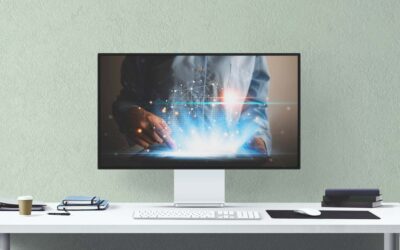3 Things to Consider When Purchasing Museum Digitization Equipment

Rachael Cristine Woody
I’m frequently asked what digitization equipment I use. There is an “it depends” factor when considering digitization tools, and there are three things I always recommend considering before making a purchase: fit, time, and budget.
This post is a great place to start if you’re considering an investment in digitization equipment; we’ll review these three main factors to consider when choosing your next piece of digitization equipment.
Digitization Equipment: Fit
Fit encompasses both a review of the item types you intend to digitize as well as the digitization standards you’d like to follow. For example: If your museum is digitizing 3D objects and only 3D objects, then a point and shoot camera setup is likely all you need. However, if your museum also contains complex objects like scrapbooks, audio-visual media, or photographic slides or negatives; then there are several additional equipment items you need.
You can read more about choosing the right tool (i.e., equipment) for the job via these related Lucidea Think Clearly posts: How to Choose the Right Tools for Museum Digital Projects, and Considering Museum Digitization Tools by Item Type.
Standards can also impact the level of equipment you invest in. For example, if you need to scan a collection of negatives, you’ll need a flatbed scanner capable of scanning at 2400 DPI, that comes with a negative tray accessory, and can perform reflective image processing.
This Lucidea Think Clearly post can help walk you through standards of different item types, which will help inform the level of quality you’re looking for when shopping: Include these Museum Digitization Standards in Your Next Project.
Digitization Equipment: Time
Time is another element to consider and of the three, it’s the easiest one to forget or not consider fully. When evaluating digitization equipment, it’s important to pay attention to the “per scan” (or similar) rate. For example, when scanning negatives at a 2400 DPI it tends to take the scanner longer to perform because the quality requirement is fairly high. Cheaper scanners may be able to scan to 2400DPI but it could take them 10 to 30 minutes. Whereas if an investment in a higher-quality model is made, the time can shorten down to just a few minutes. Even if the difference is small—just a matter of minutes—those minutes add up once you’re in the middle of a digitization project.
Digitization Equipment: Budget
Finally, there’s the budget to consider. There are two main scenarios that play out here: 1. You have a budget that matches your needs (as outlined in the fit and time sections); or 2. Your budget doesn’t match the level of your needs (as in the budget is too low). If you find yourself in scenario one—great! However, if you find yourself in scenario two it’s time to go back to the drawing board. If this is the case, I have three steps for you to take:
- Go to the budget decisionmaker and make the case for why you need to correct and increase the budget set aside for this piece of equipment. Having data from the fit and time sections will help you make this case.
- If there’s no room to increase the budget, consider if you can wait up to 12 months for additional money to be set aside, or if you must purchase something right away.
- If you must purchase something right away, consider an older or refurbished model of a high-quality scanner; or attempt to purchase as high a quality as possible with the funds you do have available with both fit and time in mind.
Conclusion
Choosing the right piece of equipment for your digitization work is an important step as it can impact the quality of the work as well as impacting staff time and project timelines. It’s important to weigh the fit and time factors against the budget to find the most appropriate balance for your team.
Additional Reading
A Thoughtful Approach to Museum Digital Project Creation
How to Construct a Museum Digitization Equation
Part 1: Create a Museum Digital Project Workflow that Works
Part 1: How Much Will Museum Digital Projects Cost Me?

Rachael Cristine Woody
Rachael Woody advises on museum strategies, digital museums, collections management, and grant writing for a wide variety of clients. In addition to authoring several titles published by Lucidea Press, she is a regular contributor to the Think Clearly blog and an always popular presenter.
Never miss another post. Subscribe today!
Similar Posts
No-Code Digital Storytelling Example: Rembrandt’s Self-Portrait at Kenwood House
Explore how English Heritage’s Kenwood House uses the no-code platform Shorthand to bring Rembrandt’s Self-Portrait with Two Circles to life through visual storytelling and interactive design.
Exploring No-Code Digital Storytelling: Hoover’s “Fanning the Flames” Exhibit
Explore no-code digital storytelling with Hoover’s ‘Fanning the Flames’ exhibit. See how interactive tools (Deep Zoom Color Compare & Hot Spot) enhance user engagement and the visual experience.
An Introduction to Scrollytelling for Museums
Discover how museums use scrollytelling and digital storytelling platforms to create immersive narratives. This introduction explores key concepts and approaches to interactive storytelling.
Exploring Self-Determinate Multiple Pathways: An Example of Digital Storytelling
Discover how self-determinate multiple pathways offer flexible interactive storytelling in museum exhibits. Learn from the Tenement Museum’s ‘Your Story Our Story.’






Leave a Comment
Comments are reviewed and must adhere to our comments policy.
0 Comments